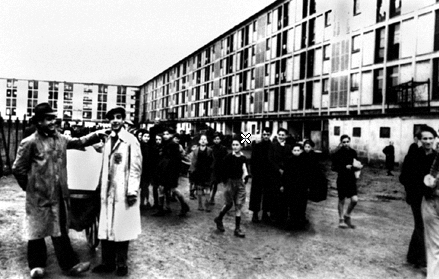
Drancy
The history of the concentration camps in France is a very difficult and sensitive subject. In 1939, before the Nazis invaded France, the French government had opened camps (like Gurs or Noe) designed to receive the Spanish refugees escaping from the fascist regime of Franco. These camps were guarded by the French police and in the summer 1940, all refugees were handed over the Nazis. They were quickly transferred to various concentration camps in Germany and very few of them survived.
The camp of Drancy was a transit camp located not far from Paris. Like many other camps in France, it was created by the government of Philippe PÈtain and was under the control of the French police. In 1941, the first raids against Jews was ordered by the Nazis and conducted by the French police. The victims of these raids were transferred to Drancy. There is much evidence about the brutality of the French guards in Drancy. The conditions of life were extremely difficult, due to neglect of personal, ordinary human needs, adequate food, unsanitary conditions, and over-crowding.

Drancy
Klaus Barbie, the notorious "Butcher of Lyon" was promoted from Holland to Dijon in the Occupied Zone of France, in June 1942, after having earned an "Iron Cross" decoration, for his success in killing Jews and shipping many to their deaths. Barbie's most impressive duty up to that time had been to execute Dutch Jews.
*On June 11, 1941 : three hundred boys between 14 and 19 years of age are sent to Mauthausen in Austria where they will test the effectiveness of the gas chambers. There were no survivors. *Annette Kahn "Why My Father Died."
Proof exists that more than 3000 prisoners died in the French camps from lack of medical care or starvation. During the nights of July 16th and July 17th, 1942 an incident occurred now called "La Rafle du Vel' d'Hiv" (The Great Raid of the 'Vel d'Hiv') - The Velodrome d'Hiver was a stadium in Paris designed for bike races. (The French destroyed the stadium after the war). This police operation had been organized after several discussions between the government of Petain and the Nazi occupation administration. The code name of this operation was "Vent printanier" (Spring Wind) and all the arrests were made by the French police under the control of French police officials. Originally, only the Jews who were older than age 16 had to be arrested. It is under the proposal of the Prime Minister Laval that all the children were arrested.
More than 12800 (3031 men, 5802 women and 4051 children aged between 2 and 12) were transferred to the Velodrome d'Hiver. The children were kept there for 5 miserable days without any food or medical care and then they were transferred to Drancy, Beaune-la-Rolande or Pithiviers. The children were separated from their parents by the French police immediately after their arrival in Drancy. The parents were transported to Auschwitz and gassed. The children stayed sometimes weeks in Drancy, without any proper care or adequate food. Several babies and very young children died in Drancy due to the lack of care and the brutality of the French guards. Finally, they were all transported to Auschwitz and gassed upon their arrival. More than 6000 Jewish children from all the regions of France were arrested and transported to their deaths between July 17th and September 30th, 1942.
There were several other camps like Drancy in France: Noe, Gurs, Recebedou, ...
During more than 40 years, the French Government refused to admit the responsibility of the regime of Petain and the French police in the deportation of the French Jews. In 1995, the president Chirac has finally admitted the responsibility of the Vichy regime during a speech in memory of the victims of the "Grande Rafle".